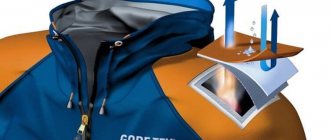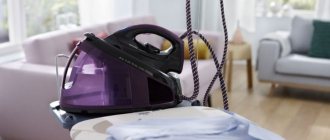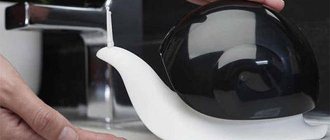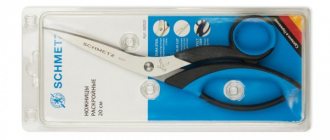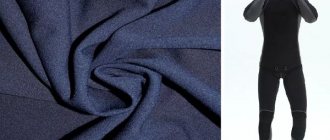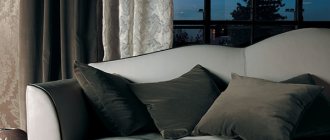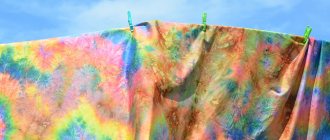It is necessary to use special detergents that do not clog pores and do not wash off the protective coating. These include liquid shampoos from brands such as Nikwax, Domal, Grangers, Perwoll, Salton and others. The washing process itself is recommended to be carried out manually, very carefully, using water at a temperature of up to 40 degrees.
By deciding to buy membrane clothing, you get a number of advantages, such as lightweight fabric, a high degree of protection from cold, moisture and wind, as well as a stylish appearance. True, you will have to face a high price and difficulties in caring for it. But, if you understand this, the benefits of such things will eventually be worth the cost and make all your efforts worth it. In order for the material to last as long as possible, you should also purchase appropriate care products for such clothing.
What should the remedy be?
The structure of the material allows moisture produced by the human body to evaporate, but does not allow wind, snow and rain to get inside. Such properties are used when sewing outerwear for adults and children (down jackets, ski suits, jackets, pants), making them comfortable, warm, suitable for sports and active movement.
A membrane is a thin layer or impregnation of small pores that is applied to the fabric.
For washing such clothes, only a substance that does not affect the structure and properties of the material is suitable. Ordinary powders and gels will not cope with this task, because they either clog the internal pores or wash off the special impregnation for the top.
The membrane fabric cleaner must meet the following parameters:
- they do not contain chlorine, which impairs the material’s ability to repel moisture;
- be produced without enzymes in the composition, which is equivalent to impregnation of upper impurities that need to be washed off;
- it is necessary to get rid of any abrasive particles that aggressively affect the membrane, clogging microscopic pores;
- be highly concentrated without performing whitening, rinsing or conditioning functions.
Due to its considerable cost, this material does not like experiments and care methods according to folk recipes. You need a product that states on the packaging that it is suitable for such clothing.
The only thing that can be replaced with powder for membrane clothing is soap without additives, finely grated and well diluted in warm water.
Features of membrane fabric
Membrane products help protect a person from moisture getting inside. In addition, they retain heat well and are resistant to wind. This is achieved through a combination of synthetic fibers and a thin film with microscopic pores. This fabric is created artificially, it is wear-resistant and lightweight.
Depending on the texture, the following types of membrane fabric are distinguished:
- Covered with a non-porous film. Clothing made from this material does not allow moisture to pass through, and various contaminants on the surface do not impair vapor permeability.
- Having porous membranes with micropores. No moisture passes through them, and steam escapes easily. However, if the pores become clogged due to various contaminants, the breathability of the fabric is greatly impaired.
- Combined materials. The surface of the fabric has no pores, but inside there is a porous layer.
The membrane jacket can be worn in any weather, and will also be comfortable during increased physical activity. This fabric ensures a constant temperature, regardless of weather conditions. Due to the lightness of the material, movement is not constrained, and if it gets dirty, it can be quickly washed.
Under membrane clothing, you should wear synthetic items or those made from combined materials. Products made from cotton fabric are prohibited, because they absorb sweat and moisture well, and this can lead to hypothermia. Thermal underwear is best. Membrane fabric has the disadvantage of fragility: after 20 washes, the material becomes very thin. In addition, such things are quite expensive and need to be carefully looked after.
How to wash properly
The membrane fabric also repels dirt, so you rarely need to wash it. Frequent washing is undesirable, since the outer layer of clothing, which is responsible for waterproofing, is very quickly removed. Before washing, make sure:
- Close all zippers and buttons.
- unpack fur parts, removable decorative parts.
- If possible, place fur that does not slip off in a plastic bag that does not allow water to pass through.
- If you are concerned about the fittings, cover them with several layers of electrical tape.
- take things out of your pocket.
- remove dirt with a napkin.
- check the label for special precautions.
For maximum care, manufacturers indicate the acceptable type of washing - hand washing. Prolonged soaking is not required, as this will negatively affect the material.
It is recommended to wash each item of clothing separately from other items.
Steps for hand washing clothes:
- Fill the container with warm water (temperature up to 40 degrees Celsius).
- Add powder or liquid for washing membrane fabrics (calculate the amount according to the instructions), mix.
- Place the element in water, after complete soaking, proceed to washing. Do not rub or twist the fabric.
- To remove stubborn stains, gently scrub the surface with a soft, foam-covered bristle brush.
- Rinse clothing thoroughly under cool running water.
- hang clothes over the bathtub until excess moisture drips out.
If you only use a washing machine, follow these guidelines when washing clothes with membranes:
- select delicate wash mode;
- Pre-clean the chamber from any residual detergents;
- insert a single element into the drum;
- set the temperature to 30-40 degrees;
- avoid automatic rotation;
- use the double rinse function.
Clothes that are no longer dripping with water should be hung vertically on hangers or placed horizontally. Thick down jackets should be turned inside out after washing.
Top 5 best cleaning liquids
A properly selected, high-quality membrane washing agent will help you achieve an ideal result, while maintaining the fabric’s ability to retain heat and remove moisture.
Rating of the most effective detergents for washing membrane clothes:
Textile Wash Plus Woly shampoo is an effective product that preserves the moisture-repellent layer and the structure of the porous membrane.
Suitable for both hand and machine washing. It perfectly removes any dirt and unpleasant odors, while maintaining the brightness of the color of the fabric.- Washbalsam gel is an ideal product for washing thermal underwear, products made from membrane fabrics, and sports shoes. Gentle treatment of the fabric will help preserve the structure of the membrane and the shape of the product. Removes any dirt and odors well.
- Gel Laska Activ Fresh will help maintain the structure of porous membrane fabric even when washed in hard water. Suitable for both hand and machine wash. The fairly large volume of the bottle and low price make Laska Activ Fresh gel very popular among consumers.
- Salton Sport shampoo penetrates deeply into the pores of the membrane, cleaning clothes not only from dust and dirt, but also from unpleasant odors. Suitable for any type of washing, requires thorough rinsing.
- Denkmit Fresh Sensation gel is an excellent product for washing membrane fabrics from a German manufacturer.
Removes any dirt (even old and ingrained ones), removes unpleasant odors. Economical consumption and affordable price make this product attractive to consumers. Features of use: Denkmit Fresh Sensation, together with dirt, removes water-repellent impregnation on fabric, therefore, after using the gel, clothes must be treated with a special impregnation.
The video will tell you how to wash membrane clothes:
Care instructions
Shampoo or gel for membranes is suitable, which is used for washing sportswear, microfiber fabrics, synthetics, and fleece. The material must not be ironed or steamed. When drying clothes, do not hang them in direct sunlight, and also ensure good air circulation in the room.
Even with proper cleaning, the top coating gradually wears out and wears off as it dries, losing the basic properties of the garment. To delay or partially correct this phenomenon, use special impregnations. They are available for sale as a spray or liquid. The most popular brands:
- Nikwax;
- Granger's;
- Collonil;
Impregnations are based on fluoride, Teflon or silicone, thanks to which drops of moisture do not penetrate, but disappear from the material. If you notice that your jacket or membrane suit is starting to get wet in some areas, replace the outer shell. To do this, when rinsing after washing, spray an even layer of spray or add liquid detergent. Be sure to carefully follow the instructions, do not use the impregnation too often, so as not to clog your pores.
How to remove a grease stain?
Special products are good at removing various contaminants from membrane fabrics, but greasy stains are sometimes difficult to remove. If you notice that there is a trace of grease on your clothes, use the product you use to wash dishes:
- Apply a small amount of liquid or gel to a soft, damp cloth.
- Gently wipe the grease stain with it.
- Wipe with a clean damp cloth.
- If it is heavily soiled, additionally wash the entire item by hand or in the washing machine.
Stain removers should not be used, regardless of their composition.
What to look for when choosing
When choosing a detergent for washing, consider how much you move and the conditions in which you use the material.
Recommendations for buyers:
- for colored items, choose a product that does not leave streaks and allows you to maintain the brightness of the color (there should be no aggressive ingredients);
- for children's clothing, adults, who often have complex stains, buy stronger, deep-acting products;
- for those who sweat a lot, a composition with disinfectant components is desirable; if you are prone to allergies, choose light, odorless “chemicals”, dyes, fragrances, and environmental powders;
- when there is a large amount of membrane clothing or frequent washing, detergents with economical consumption are preferred; travelers are suitable for universal products that are also suitable for washing tents, ropes, backpacks; for active use of such things, it is recommended to buy 2 in 1, combining stain removal and waterproof impregnation.
The price has also been cleared, but the resources for this category of clothing are too economical.
Affordable Alternative
If you couldn’t find a suitable product in the store, you can wash your clothes with laundry soap. This may seem strange, but it contains natural ingredients that wash out well and do not get stuck in the pores or harm the inner or outer layer.
When using this option, pay attention to the following recommendations:
- Buy regular laundry soap that does not contain bleaches, fragrances, dyes or other chemicals. Soap is good for baby clothes.
- To wash, make a soap solution or lightly soap the item in the most dirty places.
- Use soap only for hand washing.
Note! It is not recommended to use laundry soap frequently, but as a one-time alternative it works well for removing stains and dirt.
